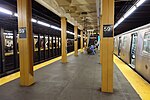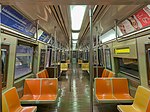58th Street station (BMT Fifth Avenue Line)
BMT Fifth Avenue Line stationsBrooklyn railway station stubsDefunct New York City Subway stations located abovegroundFormer elevated and subway stations in BrooklynRailway stations closed in 1940 ... and 2 more
Railway stations in the United States opened in 1893Sunset Park, Brooklyn
58th Street was the penultimate station on the demolished section of the BMT Fifth Avenue Line in Brooklyn, New York City. It was served by trains of the BMT Fifth Avenue Line, and had two tracks and one island platform. The station was built on October 1, 1893. The next stop to the north was 52nd Street. The next stop to the south was the 65th Street Terminal. It closed on May 31, 1940. Current rapid transit service in this area can be found one block east and then another block south at the 59th Street station on the underground BMT Fourth Avenue Line and BMT Sea Beach Line.
Excerpt from the Wikipedia article 58th Street station (BMT Fifth Avenue Line) (License: CC BY-SA 3.0, Authors).58th Street station (BMT Fifth Avenue Line)
Gowanus Expressway, New York Kings County
Geographical coordinates (GPS) Address Nearby Places Show on map
Geographical coordinates (GPS)
| Latitude | Longitude |
|---|---|
| N 40.643275 ° | E -74.019408333333 ° |
Address
Gowanus Expressway (Gowanus Expressway)
Gowanus Expressway
11220 New York, Kings County
New York, United States
Open on Google Maps







